| Columns Retired Columns & Blogs |
Audia Flight FLS1 preamplifier Measurements
Sidebar 3: Measurements
I measured the Audia Flight FLS1 using my Audio Precision SYS2722 system (see the January 2008 "As We See It"). All of its outputs—balanced, single-ended, and headphone—preserved absolute polarity (ie, were non-inverting). The FLS1's volume control operates in 0.5dB steps, with the maximum level indicated as "+10.0dB" on the front-panel display. Setting the volume control to "0.0dB" reduced the gain by exactly 10dB, as expected. The FLS1's maximum voltage gain into 100k ohms was 15.8dB for balanced input to balanced output, 9.7dB for unbalanced input to unbalanced output, and 10.1dB for unbalanced input to headphone output. The balanced input impedance measured a usefully high 96k ohms at 20Hz and 1kHz, dropping to a still-high 82k ohms at 20kHz; the unbalanced input impedance was half these values at 20Hz and 1kHz, dropping to 31k ohms at 20kHz.
The Audia Flight's output impedance is specified as 5 ohms. However, I measured 20 ohms at all audio frequencies for the balanced output, and 10 ohms for the unbalanced output. The headphone output impedance was too low to measure accurately, at <1 ohm. The FLS1's frequency response was extraordinarily wide, the output at 200kHz lying at –0.7dB (fig.1, blue and red traces). Fig.1 was taken with balanced operation and the volume control set to "0.0." Commendably, the response didn't change with the setting of the volume control or with unbalanced operation.
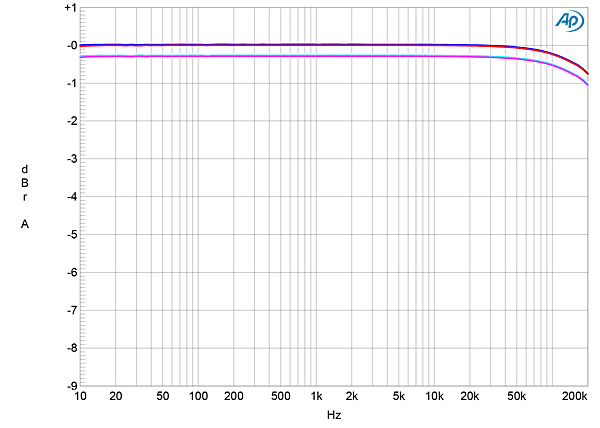
Fig.1 Audia Flight FLS1, balanced output, volume control at max, frequency response at 1V into: 100k ohms (left channel blue, right red), 600 ohms (left cyan, right magenta) (1dB/vertical div.).
Channel separation for balanced and unbalanced operation was superb, and the same in both directions, at >120dB below 5kHz and still >110dB at the top of the audioband. The unweighted, wideband signal/noise ratio, measured at the line outputs with the inputs shorted to ground but the volume control set to its maximum, was very good, at 79.2dB ref. 1V output. This improved to 91.5dB when the measurement bandwidth was restricted to 22Hz–22kHz, and to 97.7dB with an A-weighting filter switched into circuit. Fig.2 shows a spectral analysis of the Audia Flight's low-frequency noise floor while its balanced output drove a 1kHz tone at 1V into 100k ohms with the volume control set to "+10.0dB." The random noise-floor components lie close to –130dB, with the power-supply–related spuriae primarily odd-order, and a little higher in the left channel (blue trace) than the right (red).
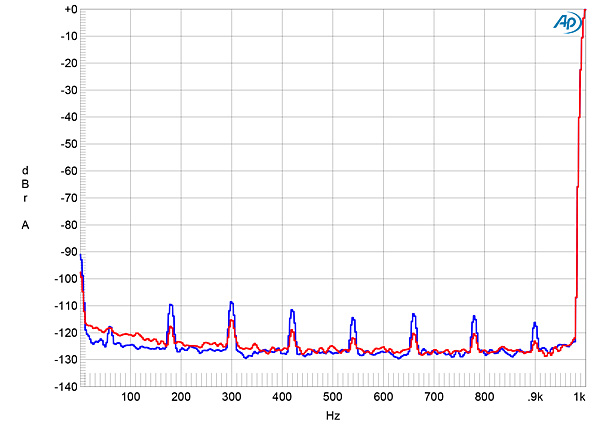
Fig.2 Audia Flight FLS1, balanced output, volume control at max, spectrum of 1kHz sinewave, DC–1kHz, at 1V into 100k ohms (linear frequency scale) (10dB/vertical div.).
With clipping defined as when the THD+noise reaches 1%, the FLS1 clips at 50V balanced (fig.3) and 25V unbalanced (fig.4). These extraordinarily high clipping voltages were maintained into the punishing 600 ohm load. The fact that the trace in fig.3 slopes downward from left to right below 3V means that the distortion actually lies below the already-low noise floor at these lower output levels. I measured the percentage of THD+N against frequency at a level, 5V into 100k ohms, where I could be sure that I was looking at THD rather than noise. Even so, the distortion was extremely low in the bass and midrange, rising gently above 500Hz due to the decreasing open-loop gain as the frequency rose (fig.5). This behavior suggests that the FLS1's circuit uses a high amount of negative feedback.
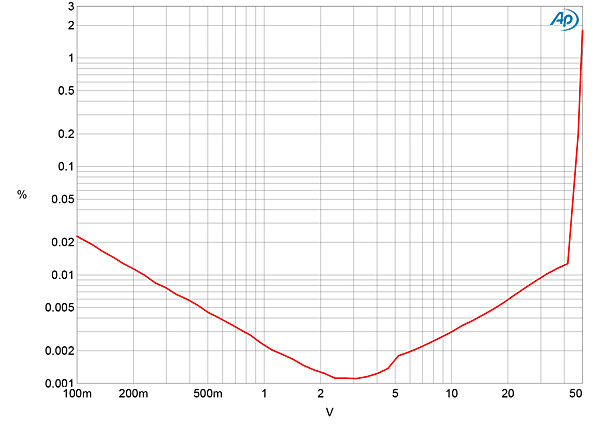
Fig.3 Audia Flight FLS1, balanced output, distortion (%) vs 1kHz output voltage into 100k ohms.
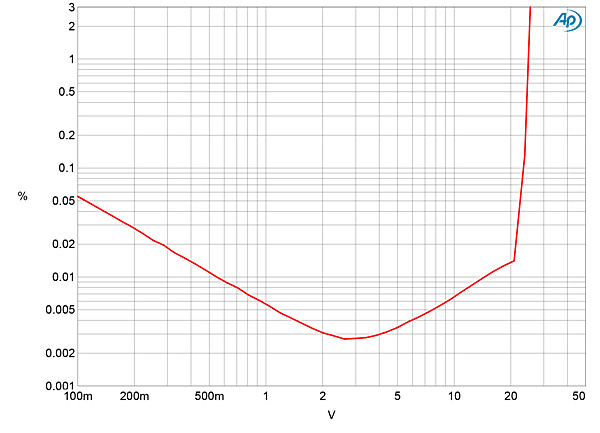
Fig.4 Audia Flight FLS1, unbalanced output, distortion (%) vs 1kHz output voltage into 100k ohms.
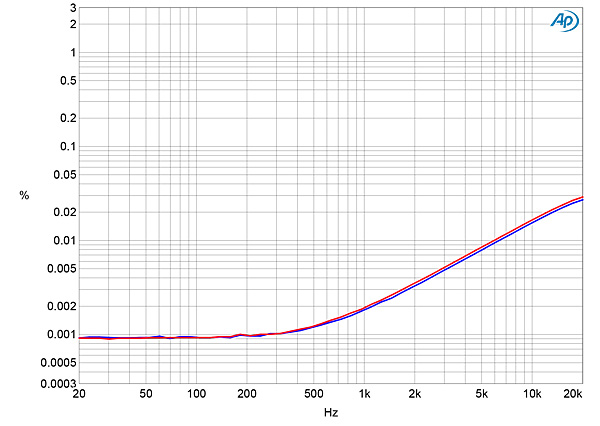
Fig.5 Audia Flight FLS1, balanced output, THD+N (%) vs frequency into 100k ohms.
At a typical balanced output level, 2V into 100k ohms, the distortion was almost unmeasurable, with both the second and third harmonics lying at or below –120dB (0.0001%, fig.6). With the single-ended output at the same level (fig.7), while the third harmonic remained at –120dB, the second harmonic rose to –106dB (0.0005%). (A balanced circuit tends to cancel even-order distortion, due to the improved waveform symmetry.) An equal mix of 19 and 20kHz tones at 2V into 100k ohms was reproduced with the second-order difference product at 1kHz completely absent (fig.8). Though the higher-order intermodulation products are visible in this graph, they are all still very low in absolute terms. Unusually, these very low levels of harmonic and intermodulation distortion were maintained into low impedances.
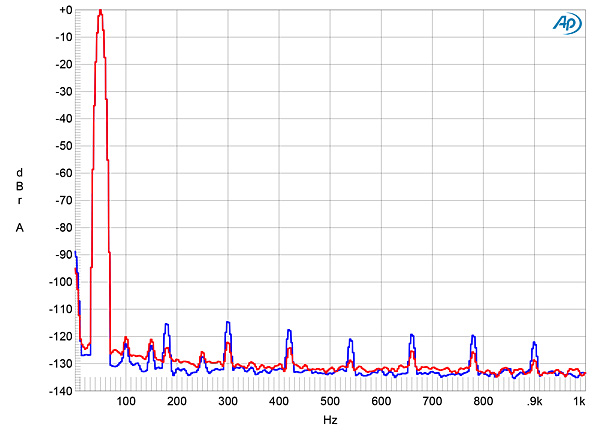
Fig.6 Audia Flight FLS1, balanced output, volume control at max, spectrum of 50Hz sinewave, DC–1kHz, at 2V into 100k ohms (linear frequency scale).
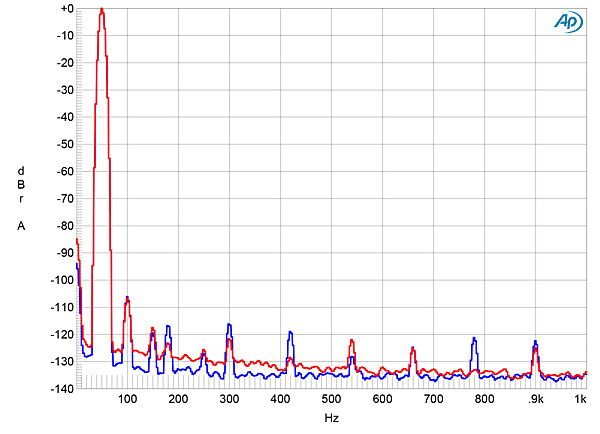
Fig.7 Audia Flight FLS1, unbalanced output, volume control at max, spectrum of 50Hz sinewave, DC–1kHz, at 2V into 100k ohms (linear frequency scale).
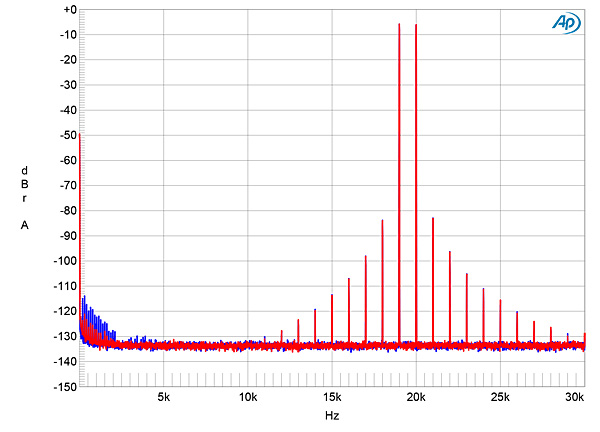
Fig.8 Audia Flight FLS1, balanced output, HF intermodulation spectrum, DC–30kHz, 19+20kHz at 1V peak into 100k ohms (linear frequency scale).
Our review sample of the FLS1 was fitted with the optional moving-magnet/moving-coil phono board with unbalanced inputs. As always when I test phono stages, I experimented with the grounding between the preamp and the Audio Precision system to get the lowest level of noise. I ended up floating the Audio Precision's outputs from ground and connecting the Audia Flight card's grounding post to the analyzer ground. I left the card's DIP switches as set by Michael Fremer for his auditioning.
The FLS1 preserved absolute polarity with both MC and MM inputs. Measured at the single-ended preamp outputs with the volume control set to "0.0dB," the MM input offered 45.1dB of gain, the MC input 63.5dB, both values measured with the AP output impedance set to 20 ohms and appropriate for the type of phono cartridge.
The input impedance for the MM input was appropriately high, at 44.2k ohms at 20Hz and 1kHz, dropping slightly to 39k ohms at 20kHz. As set by MF, the MC input impedance was 100 ohms at all audio frequencies. The RIAA equalization offered superbly low error from 100Hz to 20kHz, with the two channels very well matched (fig.9). The low frequencies rolled off, however, reaching –3dB at 17Hz, while the ultrasonic response dropped sharply above 50kHz.
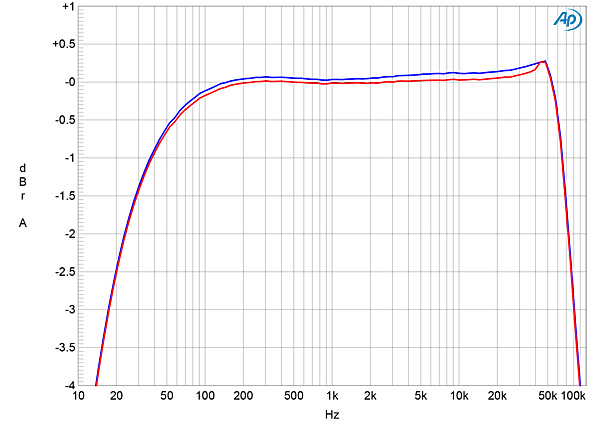
Fig.9 Audia Flight FLS1, MM input, response with RIAA correction (left channel blue, right red) (1dB/vertical div.).
The Audia Flight phono card's S/N ratio, measured with the input shorted to ground, depended on whether the MC or MM input was being used. The unweighted, wideband ratio for the MM input was an excellent 71.5dB in the right channel, 74.4dB in the right, both figures ref. 1kHz at 5mV. Restricting the measurement to the audioband respectively improved these ratios to 80.2 and 81.2dB, and an A-weighting filter further improved both to 75.2dB. Despite the extra gain of the MC input, the S/N ratios, ref. 1kHz at 500µV, were still very good, at 67.7dB (unweighted wideband), 69.3dB (22Hz–22kHz), and 73.5dB (A-weighted).
Harmonic distortion was very low, with the second harmonic the highest in level at –80dB (0.01%), despite the MM input signal lying at 25mV (fig.10). As suggested by this graph, lower-frequency phono overload margins were superb, at 24.5dB MM and 29.8dB MC at 20Hz, and 21.2dB MM and 22.7dB MC at 1kHz. The margin decreased as the frequency rose, however, measuring 7.6dB MM and 8.9dB MC at 20kHz. I therefore measured the high-frequency intermodulation spectrum (fig.11) at a lower level than usual, 55mV: the intermodulation products all lay at or below –80dB (0.03%).
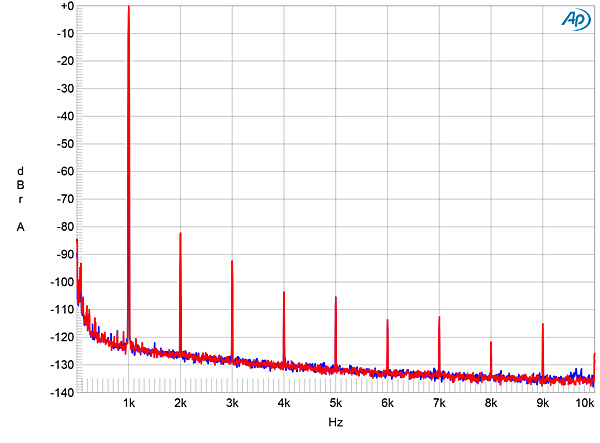
Fig.10 Audia Flight FLS1, MM input, spectrum of 1kHz sinewave at 25mV, DC–10kHz (linear frequency scale).
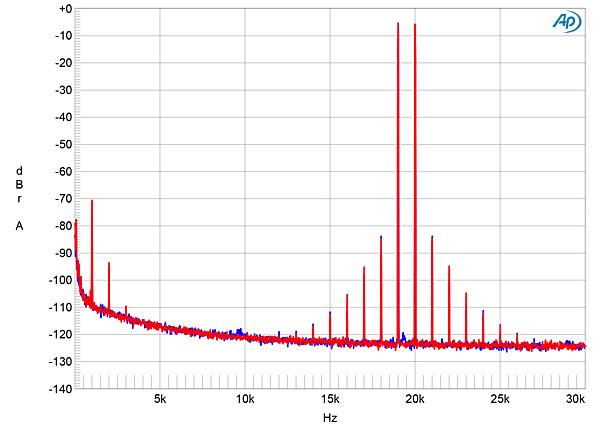
Fig.11 Audia Flight FLS1, MM input, HF intermodulation spectrum, DC–30kHz, 19+20kHz at 55mV peak (linear frequency scale).
Overall, Audia Flight's FLS1 offered simply superb measured performance.—John Atkinson
- Log in or register to post comments




































